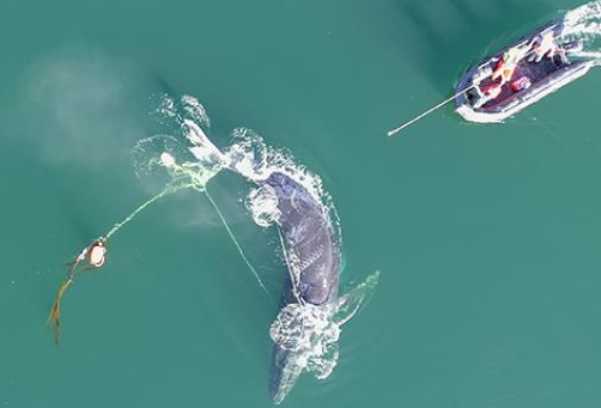Alaska
Successful Effort to Rescue an Entangled Humpback Whale – Alaska Native News

Trained responders freed the whale from a life-threatening entanglement near Gustavus

On October 10, NOAA Fisheries received reports of a severely entangled whale in coastal waters near Gustavus. A quick response by a dedicated team of trained responders—involving planes, drones, vessel- and shore-based efforts—helped free the juvenile humpback whale.
“The Glacier Bay National Park entanglement response team was critical in this effort. They provided the vessel and staff to successfully evaluate the whale’s condition and then deployed a team to disentangle the whale,” said Sadie Wright, Large Whale Entanglement Response Coordinator, NOAA Fisheries Alaska Regional Office. “We are grateful to the Gustavus residents who reported the whale in distress, the Alaska Whale Foundation, volunteer Sean Neilson, and support teams within NOAA for their expertise and help in the effort, as well as the owner of the fishing gear who provided information that helped us determine our best approach for freeing the whale.”
Assessing the Whale’s Condition
Janet Neilson and Chris Gabriele with National Park Service’s large whale entanglement response team coordinated shoreline and vessel-based assessments shortly after the first reports of the entanglement. They provided information needed to assemble the right team and equipment to mobilize a timely response.
“Glacier Bay National Park Service personnel located the whale from shore and confirmed it was dragging two buoys. They were able to get out on the water right away to confirm the entanglement and take photos of the animal and gear that helped paint a much more thorough picture,” said Janet Neilson.
Based on the assessment, the team determined that the entanglement was life-threatening. The whale appeared to be semi-anchored in place by line and buoys associated with a crab pot.
“We spoke with the gear owner who was really helpful in providing details that allowed us to better understand the type and configuration of the gear entangling the whale,” said Wright. “The gear included a heavy gauge line and buoys attached to a 300-pound crab pot.”
Deploying the Response Team
A team was deployed from Juneau to Gustavus on the morning of October 11. The team consisted of:
- Core Glacier Bay National Park Service large whale entanglement response personnel
- Advanced responder Fred Sharpe with the Alaska Whale Foundation
- Volunteer photographer and FAA licensed drone pilot Sean Neilson
By 11 a.m., the team was on site and ready to get to work.
To help with assessment and strategy, the response team used a drone to collect aerial photographs and video of the whale. This gave an important perspective on how the whale was entangled. Drone pilot Sean Neilson was able to work from the shore near the boat-based entanglement response effort. He was able to talk to the team over the radio and, at times, return to the main National Park Service vessel to review footage with the team.
“This was a complicated entanglement with a line through the whale’s mouth, and wrapped around the animal’s tail stock,” said Fred Sharpe, advanced large whale entanglement responder with Alaska Whale Foundation. “The drone imagery assisted tremendously with our understanding of the entanglement and how to prioritize our cutting attempts.”
Support teams with NOAA in Juneau, and NOAA whale disentanglement expert Ed Lyman at the Hawaiian Islands Humpback Whale National Marine Sanctuary on Maui assessed the drone imagery. They provided recommendations by cell phone as the team worked with the whale.
The sky was clear and the seas were calm. As the entanglement was so late in the season, mild conditions were fortuitous in aiding the responders efforts to help the whale. Using specialized tools to remove the line and buoys, the team got to work. The response team patiently and deliberately made several cuts using specialized tools designed to keep responders at a safe distance from the whale. This includes a knife on the end of a 25-foot carbon fiber pole and grappling hooks modified with razor-sharp knife blades inside the grapple to cut as they grab. They were able to remove nearly all of the line and the buoys.
Near the end of the day, the strategic approach paid off—the whale became more mobile with each cut of the rope until the gear finally loosened. “The turning point came when we were able to cut the rope that ran through the whale’s mouth and was wrapped around its tail,” said Gabriele, a whale biologist with Glacier Bay National Park and Preserve.
The whale was able to swim away, leaving the buoys and most of the line floating at the surface. While all of the floating portions of the line were collected, the pot hasn’t been recovered yet. It is likely sitting on the seafloor where the whale was last seen.
The next day, Janet Neilson matched photos of the entangled whale’s fluke pattern to a known individual, SEAK-5490. This young whale was first documented by the Alaska Whale Foundation in 2021 and had been seen twice in the Glacier Bay area earlier in 2023. The Happywhale website uses computer algorithms to match humpback whale flukes and help track individual whales through contributed sightings. You can view photos and “follow” this whale to be notified of any future sightings.
“Glacier Bay National Park staff plan to look for this animal in the coming weeks and document its condition if it is still in the area, and NOAA Fisheries staff will continue to seek resights to hopefully confirm the animal is in good condition and back to normal feeding and migration,” added Wright.
“The Alaska teams have been busy this summer with multiple responses in Southeast Alaska. This disentanglement response went very well due to the dedication and expertise of a number of organizations and personnel. Their training and commitment paid off, and helped this whale survive,” said Ed Lyman, who acts as a regional large whale entanglement response coordinator under NOAA Fisheries’ Marine Mammal Health and Stranding Response Program. Lyman has been leading large whale entanglement response trainings in Alaska for more than 15 years. He led a refresher course for Glacier Bay National Park staff in 2022. Due to the risks involved to animals and responders, NOAA’s Marine Mammal Health and Stranding Response Program oversees and authorizes large whale entanglement response efforts nationally.
What to Do if You See an Entangled Whale
If you see an entangled whale, do not approach it. Contact experts who have the training and specialized equipment to respond. Getting too close to a very large and likely distressed animal can be dangerous—even life threatening. Entangled whales frequently avoid boats after repeated close encounters, making disentanglement efforts even more difficult. Cutting visible gear off can actually make things worse, so it’s best to keep your distance and leave it to the experts.
To help an entangled whale, call NOAA’s 24/7 entanglement hotline at (877) 9-AKR-PRD ((877) 925-7773), or hail the U.S. Coast Guard on VHF Channel 16 and they will relay the report.
If you’re interested in learning more about becoming a first responder, take the online training developed by NOAA in partnership with The Nature Conservancy. It will teach you how to more effectively document and communicate with NOAA to help free entangled whales. These reports are the best way to help the animal. The information gained also helps us better understand entanglements and how to reduce entanglements and their impacts in the future.
NOAA/Alaska Regional Office
Related

Alaska
As summer travel trends have shifted, great deals are available in the state for Alaskans

This summer was shaping up to be a banner year for Alaska’s tourism industry. Rates were high and availability was scarce.
But things are different now. Many visitors to Alaska are worried about their jobs and their retirement accounts. The uncertainty from federal job cuts and stock market drops caused many travelers to cancel or defer their trips.
That means there is last-minute space available at many destinations around the state. That includes hotels, resorts, cruises and excursions.
Many operators now are extending special offers to Alaska residents. There are a bunch of deals, but most of them are for the month of June. Other offers are available all season long
Alaskans are well-situated to take advantage of last-minute deals. Here are some of my favorites:
1. Stan Stephens Cruises in Valdez offer cruises each day to Mears Glacier and Columbia Glacier. The regular price ranges from $169-$189 per adult. Alaska residents can take 30% off any cruise between now and June 20. Use the code AK30 or call 866-867-1297.
2. Alyeska Resort offers up to 30% off for Alaska residents. The best deals are between now and the end of May, but rates are subject to change without notice. For a midweek stay next week, it’s $182 per night, down from $259 per night. Add $47 in taxes and fees, for a total of $229 per night.
3. Alaskan Dream Cruises in Sitka is offering Alaska residents a 70% discount off normal cruise rates on its fleet of four small, luxury vessels. The ships ply the waters between Sitka, Juneau and Ketchikan including Glacier Bay, Tracy Arm and all sorts of hidden bays along the Inside Passage. The discount is available on select sailings all summer long.
For example, the “North to True Alaska” itinerary on the Chichagof Dream is usually starts at $3,995 per person during July. The ship can carry up to 74 passengers. Alaska residents can sail for as little as $1,199 per person. The price includes all accommodations, meals and activities.
Check the website for itinerary details. But you cannot book the cruise online. You have to call to make reservations: 855-747-8100.
4. The Alaska Collection by Pursuit operates the Seward Windsong Lodge, the Talkeetna Alaskan Lodge and the Denali Cabins. Alaska residents can take 20% off between now and June 15. Book online or call 800-808-8068.
Pursuit also operates Kenai Fjords Cruises in Seward. Alaska residents can request a 20% discount on any cruise.
5. Alaska Wildland Adventures is offering a 2-for-1 special at the Kenai Fjords Glacier Lodge, located inside the park near the Aialik Glacier. A three-day/two-night stay at the lodge during June usually costs $2,175 per night. With the half-off deal in June, it comes down to $1,087.50 per adult (double occupancy).
The lodge is one of three that the company operates on the Kenai Peninsula.
The price includes a glacier and wildlife cruise, which ends with a beach landing to access the lodge. All meals, accommodations and activities at the lodge also are included. The lodge is unique, since it’s built inside the park. You can’t see it from the water.
Call 800-334-8730 and tell the reservations agent the code word “LOCAL” to get the discount.
6. Major Marine Tours offers Alaska residents 20% off any of its cruises from Seward all season long.
7. Nova Alaska River Runners now offers 20% off any of its whitewater day trips. I first saw the offer as a deal for Alaska residents, but it’s now available to everyone. This includes trips on the Matanuska River and on Six Mile Creek, which is accessible via the Seward Highway. Use code “RAFT50” for online reservations or call 907-745-5753.
8. Chena Hot Springs, located about 54 miles outside of Fairbanks, offers Alaska residents a $60 per night discount on its rooms all summer. The “Fox” rooms include two double beds, for $209 per night. With the discount applied, the nightly rate drops to $149 per night. The “Moose” rooms include two queen beds, for $299 per night ($239 per night with the discount). There’s an additional $20 per night charge for taxes. Two passes to the swimming pool and hot springs are included with each room. Call 907-451-8104.
9. Princess Alaska Lodges and Holland America Hotels, both owned by Carnival Corp., are offering a season-long special of 50% off the second night. Princess has lodges in Cooper Landing, near Copper Center, in Fairbanks, near Talkeetna and near the entrance to Denali National Park. Holland America has hotels near Denali, in Dawson City and Skagway.
Princess also operates private rail cars between Anchorage and Denali, featuring package pricing with the Princess resorts along the way. Princess is offering a 25% discount on the packages. For a three-day/two-night package from Anchorage to the Mt. McKinley Princess near Talkeetna, the price is $599 per person, double occupancy. That includes train fare, transfers from the Talkeetna train station to the lodge, 60 miles, and accommodations at the lodge.
10. Prices on airfare to select destinations in Europe are lower this summer on Condor‘s nonstop flight to Frankfurt. Fly nonstop between Anchorage and Frankfurt between now and July 8 for $670-$700 round-trip, or later in the summer between Aug. 8 and Sept. 17. That’s the basic economy price, so it costs more for checked bags, advance seat assignments and a host of other “extras.” Almost every single traveler will end up paying more.
Similar prices are available for flights on Condor to Rome, Milan, Berlin and Zurich.
Several operators indicated more discounts may be available for travel later in the summer.
Alaska resident discounts are not a universal feature for all operators or hotels. But there are many more of these offers this summer. If you’re planning a trip around the state this year, it’s worthwhile to check to see if a “locals” discount applies!
Alaska
Opinion: A troubling vote for Alaska — and for the nation

It’s only been a few months, but after observing recent actions in Congress, I feel compelled to speak out. The House’s passage of the so-called “budget” bill represents a profound failure to lead, and the fact that Alaska’s lone representative cast the deciding vote makes it especially painful, as that member is my nephew, Nick Begich.
I had hoped — both for Alaska’s sake and our family — that Nick would chart an independent course in Congress, as Don Young, Mary Peltola and even my father once did. I hoped he would challenge falsehoods and act in Alaska’s best interests, not follow the lead of a president widely viewed as the most corrupt in our lifetime. I was wrong.
Nick has voted in lockstep with this administration — earning an early endorsement from the president — and has done so despite the consequences to our state. As reported by the Anchorage Daily News, Nick claimed on social media that the bill “marks the single most significant step toward restoring fiscal sanity in a generation.” That statement is demonstrably false.
This bill does not reduce the deficit. It extends tax cuts for the wealthiest Americans while cutting Medicaid and SNAP benefits, which help Alaskans survive. If Alaska tries to shield our residents from these cuts, we could face at least a $63 million shortfall. Even with these harsh sacrifices, the nonpartisan Congressional Budget Office projects that the bill will add trillions to the federal deficit. That’s not fiscal responsibility — it’s deception. To claim otherwise is to follow the Trump playbook: say something loud enough, and hope no one notices the truth.
But the bill goes even further. One provision removes the courts’ ability to hold government officials in contempt for defying court orders, effectively eliminating a vital check on executive power. With this change, any administration could disregard court rulings — with impunity — unless a citizen can afford an expensive legal battle. This is not a partisan issue. Republican or Democrat, every American should be concerned by this blatant attempt to weaken the judicial branch and undermine the rule of law.
My father, Rep. Nick Begich Sr., worked across the aisle in the 1970s to help settle the Alaska Native Land Claims, secure the pipeline right-of-way and protect Alaska’s most vulnerable. As a professor and legislator, he understood the importance of checks and balances. He knew that winning didn’t mean destroying your opponents or silencing dissent. He would be outraged by this administration’s disregard for democratic norms — and by the complicity of those who remain silent. He would have spoken up.
My nephew may share my father’s name, but he does not share his values. If he did, he would speak up against corruption. He would reject authoritarian tactics and defend the right to dissent. He would stand with the Alaskans who have the least power and the most to lose.
Instead, he has chosen a darker road — one where dissent is punished, courts are weakened, and the concentration of power is celebrated. That is not the America my father served. It is not the Alaska I know.
I hope Nick reads this. I hope he remembers that leadership means more than loyalty to a party or a president. It means doing the hard thing when it’s right. It means standing alone if necessary, for the people you represent. There is still time to choose a different path — one of integrity and courage. One that honors the legacy of those who came before and reminds us of what public service can truly be.
Tom Begich is a former minority leader of the Alaska State Senate and the executive director of the Nicholas J. and Pegge Begich Public Service Fund. His views here are his own and do not represent the fund.
• • •
The views expressed here are the writer’s and are not necessarily endorsed by the Anchorage Daily News, which welcomes a broad range of viewpoints. To submit a piece for consideration, email commentary(at)adn.com. Send submissions shorter than 200 words to letters@adn.com or click here to submit via any web browser. Read our full guidelines for letters and commentaries here.
Alaska
An audio postcard celebrating the work of Alaska’s maritime professionals

National Maritime Day is May 22. It’s a small but important holiday recognizing the hard work that goes into a career at sea. Alaska is home to thousands of mariners, including fishermen, navigators, maintenance specialists and law enforcement.
KUCB’s Andy Lusk linked up with some local maritime professionals to hear about their experiences in the industry. This audio postcard features some of those interviews.
Thank you to those who interviewed for this story:
Karoly “Charlie” Gaspar
Timothy Davis
Steve White
David Arzt
Phillip Thorne
-

 Technology1 week ago
Technology1 week agoMeta asks judge to throw out antitrust case mid-trial
-

 Movie Reviews1 week ago
Movie Reviews1 week agoClassic Film Review: ‘Mad Max: Fury Road’ is a Lesson in Redemption | InSession Film
-

 World1 week ago
World1 week agoCommissioner Hansen presents plan to cut farming bureaucracy in EU
-

 News1 week ago
News1 week agoVideo: Doctors Heal Infant Using First Customized-Gene Editing Treatment
-

 News1 week ago
News1 week agoNew Orleans jailbreak: 10 inmates dug a hole, wrote ‘to easy’ before fleeing; escape plan found
-

 Movie Reviews1 week ago
Movie Reviews1 week agoDevil’s Double Next Level Movie Review: Trapped in a punchline purgatory
-

 Business1 week ago
Business1 week agoVideo: How Staffing Shortages Have Plagued Newark Airport
-

 Business1 week ago
Business1 week agoConsumers Show Signs of Strain Amid Trump's Tariff Rollout












